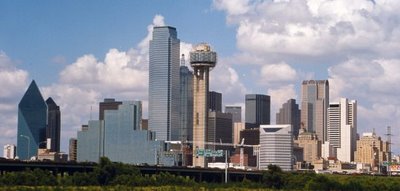
America’s downtown areas find themselves in the midst of a resurgence for sure.
Recently, The Brookings Institute conducted a study of the past 30 years in the nation’s central cities to see what was up.
Their findings seem important.
--During the 1990s, downtown populations grew by 10%--this followed two decades of steady and dramatic decline.
--Downtown areas are home to some of the most and the least affluent households of their regions. Twenty of the downtown areas studied—including Dallas—have at least one tract of housing in which the median income is higher than the surrounding metropolitan areas. In addition, 38 have at least one housing tract 50% or more lower than the median incomes of their respective regions. Rich and poor live in close proximity in many downtown areas.
--Downtowns have a higher percentage of both young adults and college-educated residents than the nation’s cities and suburbs.
--In 2000, 25- to 34-year-olds represented nearly 25% o the downtown population—up from 13% in 1970.
--Approximately 44% of people living downtown had earned a bachelor’s degree or higher.
Dallas is definitely experiencing a “boom” downtown.
Upscale loft conversions are going on in lots of old, abandoned buildings.
Luxury condos fill out the redesign of old, once long-vacant office towers.
I saw a sign just last week that read, “Live in luxury, walk to work!”
No doubt, the face and shape of downtown America is being transformed.
Who will be allowed to “play” in this new game?
Who will be shut out?
If you are interested in the full report from Brookings, take a look at http://www.brookings.edu/.
(My thinking for this post started with a brief essay and summary of The Brookings report found in Affordable Housing Finance magazine, January 2006, page 6.)
3 comments:
We lived in one of the over-priced downtown lofts and never will again until and unless Dallas decides what it wants to be when it grows up.
In every way our building was a microcosm of the city at large: wealthy living side-by-side with Section-8 entitlements separate and apart. The proximity never bred community, just toleration and frequently, subtle resentment. It was an awful, combustible mix. Having lived in other major downtowns (Chicago, NY and Los Angeles) we couldn't understand why Dallas had/has such polarized races, ethnicities and socio-economic groups. Still don't.
Such simple things are lacking in downtown, like life on the streets, available services, energy...things that don't disappear after five. Typically, the only people we found on the streets after dark were the homeless, many of whom we came to know well.
Our discovery of the underground Dallas came as a shock. When people are hidden in undergorund shops and services between 9 and 5, how will Dallas ever have the look and feel of a thriving city? For a city to thrive, don't you need people? People you can see and hear and interact with regularly?
Over time, we've come to believe that the downtown "boom" is a myth, perpetuated by the Dallas News, Chamber of Commerce and City Hall. "Thriving"? Well yes, compared to being dead entirely, I suppose it is. The question is: compared to what? As long as Dallas continues to look back on what it WAS instead of what it CAN BE, it will continue to burp and stumble into the future.
When we entertain visitors from out of state, to a person they are shocked by what a "sleepy",
"insufficient" and "pseudo-city" Dallas is. All ask what Dallas sees as its identity; we never know how to answer. Do you? Do your readers?
Anonymous, great insights. I would love to hear what others think.
Community will not happen without intentionality. The project we are working on will provide that.
I would be interested to know more about the mix of residents in the building you speak of.
RE: over-priced downtown lofts
The resident mix ranged from professionals with more money than they knew what to do with (as evidenced by discarded shoe boxes with $450 price tags, deliveries from Stanley Korshak, etc.) to workaday blue collars receiving Section 8 subsidies. (We didn't know what Section 8 was until we overheard someone on the elevator refer to another tennant as a "Section Eighter". We eventually understood the intent; I still wince.)
The 120+ units varied in size (approx. 500 - 2700 sq.ft) and price ($1-$2/sq.ft) depending upon the appointments and amenities. Have no idea what percentage was/is Sec. 8, but understood from the property manager that Sec.8 subsidies are common "concessions" to secure redevelopment funds. True?
Yes, community does require intentionality. We also like diversity, in race, ethnicity, income, education ... all of it. In fact, we believe in 511 Akard and everything CDM stands for, in word and deed. To many of us, you are the bright light downtown needs to light the way ahead. We're doing our part on the fringes, moving with you in the same direction.
Post a Comment